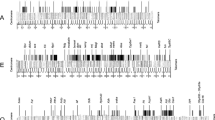Abstract
The protozoan parasite,Giardia duodenalis, is regarded as the most primitive eukaryote. The two apparently identical nuclei presumably carry the same chromosomes but the number of different chromosomes in the organism is unknown. A genome map ofG. duodenalis is required to resolve this issue and mapping studies were initiated using chromosome 5. This chromosome was estimated to be approximately 2 Mb whenGiardia chromosomes were separated by contour-clamped homogeneous electric field gel electrophoresis. A plasmid library of chromosome 5-specific DNA sequences was constructed from gel-extracted chromosome 5 and selected probes were used as markers to identifyNotI DNA segments derived from chromosome 5. Fiftynine unique copy markers were used to identify thirteenNotI segments which ranged in size from 47 kb to 400 kb. The sum of theNotI segments was 1.78 Mb which indicated that most, if not all, of the chromosome was accounted for and that chromosome band 5 of the cloned line WB-1B, used in this study comprised only one chromosome type. TheNotI segments were ordered on the map by comparison of hybridization patterns of the markers with partialNotI cleavages of whole chromosomes. Chromosome rearrangements occur readily inGiardia, and in two drug-resistant lines selected for resistance to different drugs, partial conservative duplications of chromosome 5 were observed in addition to the original, full length chromosome 5. Both duplications retained the central region of chromosome 5 but were deleted at different termini resulting in one duplication of 1.5 Mb and the other of 1.3 Mb. The duplicated chromosomes which appeared to be in lower copy number than the parent chromosome gave rise to a stable aneuploid organism. Chromosome maps of organisms with weak genetic databases, such asGiardia, will be extremely useful for determining genome organisation and plasticity.
Similar content being viewed by others
References
Adam RD (1992) Chromosome-size variation inGiardia lamblia: the role of rDNA repeats.Nucleic Acids Res 20: 3057–3061.
Adam RD, Nash TE, Wellems TE (1988) TheGiardia lamblia trophozoite contains sets of closely related chromosomes.Nucleic Acids Res 16: 4555–4567.
Adam RD, Nash TE, Wellems TE (1991) Telomeric location ofGiardia rDNA genes.Mol Cell Biol 11: 3326–3320.
Birnboim HC, Doly J (1979) A rapid alkaline extraction procedure for screening recombinant plasmid DNA.Nucleic Acids Res 7: 1513–1523.
Boothroyd JC, Wang A, Campbell DA, Wang CC (1987) An unusually compact ribosomal DNA repeat in the protozoanGiardia lamblia.Nucleic Acids Res. 15: 4065–4084.
Boreham PFL, Phillips RE, Shepherd RW (1986) Activity of drugs againstGiardia intestinalis in neonatal mice.J Antimicrob Chemother 18: 393–398.
Capon AG, Upcroft JA, Boreham PFL, Cottis LE, Bundesen PG (1989) Similarities ofGiardia antigens derived from human and animal sources.Int J Parasitol 19: 91–98.
Church GM, Gilbert W (1984) Genomic sequencing.Proc Natl Acad Sci USA 81: 1991–1995.
de Jonckheere JF, Majewska AC, Kasprzak W (1990)Giardia isolates from primates and rodents display the same molecular polymorphism as human isolates.Mol Biochem Parasitol 39: 23–28.
Fan J-B, Koman SH, Cantor CR, Smith CL (1991).Giardia lamblia: haploid genome size determined by pulsed field gel electrophoresis is less than 12 MBb.Nucleic Acids Res 19: 1905–1908.
Feinberg AP, Vogelstein B (1984) Addendum. A technique for radiolabelling DNA restriction endonuclease fragments to high specific activity.Anal Biochem 137: 266–267.
Healey A, Mitchell RW, Upcroft JA, Boreham PFL, Upcroft P (1990) Complete nucleotide sequence of the ribosomal RNA tandem repeat unit fromGiardia intestinalis.Nucleic Acids Res 18: 4006.
Kabnick KS, Peattie DA (1990)In situ analyses reveal that the two nuclei ofGiardia are equivalent.J Cell Sci 95: 353–360.
Le Blancq SM, Korman SH, van der Ploeg LHT (1991) Frequent rearrangements of rRNA-encoding chromosome inGiardia lamblia.Nucleic Acids Res 19: 4405–4412.
LeBlancq SM, Korman SH, van der Ploeg LHT (1992) Spontaneous chromosome rearrangements in the protozoanGiardia lamblia: estimation of mutation rates.Nucleic Acids Res 20: 4539–4545.
Morzaria SP, Young JR (1992) Restriction mapping of the genome of the protozoan parasiteTheileria parva.Proc Natl Acad Sci USA 89: 5241–5245.
Oliver SG, van der Aart QJM, Agostoni-Carbone MLet al. (1992) The complete DNA sequence of yeast chromosome III.Nature 357: 38–46.
Olsen M, Hood L, Cantor C, Botstein D (1989) A common language for physical mapping of the human genome.Science 245: 1434–1435.
Sogin ML, Gunderson JH, Elwood HJ, Alonso RA, Peattie DA (1989) Phylogenetic meaning of the kingdom concept: an unusual ribosomal RNA fromGiardia lamblia.Science 24: 75–77.
Southern EM (1975) Detection of specific sequences among DNA fragments separated by gel electrophoresis.J Mol Biol 98: 503–517.
Townson SM, Laqua H, Upcroft P, Boreham PFL, Upcroft JA (1992) Induction of metronidazole and furazolidone resistance inGiardia.Trans R Soc Trop Med Hyg 86: 521–522.
Triglia T, Wellems TE, Kemp DJ (1992) Towards a high-resolution map of thePlasmodium falciparum genome.Parasitol Today 8: 225–229.
Upcroft JA, Upcroft P (1993a) Drug resistance andGiardia Parasitol Today 9: 187–190.
Upcroft P, Upcroft JA (1993b) Comparison of properties of agarose for electrophoresis of DNA.J Chromatogr 618: 79–93.
Upcroft JA, Boreham PFL, Upcroft P (1989) Geographic variation inGiardia karyotypes.Int J Parasitol 19: 519–527.
Upcroft JA, Healey A, Mitchell R, Boreham PFL, Upcroft P (1990) Antigen expression from the ribosomal DNA repeat unit ofGiardia intestinalis.Nucleic Acids Res 18: 7077–7081.
Upcroft JA, Healey A, Murray DG, Boreham PFL, Upcroft P (1992) A gene associated with cell division and drug resistance inGiardia duodenalis.Parasitology 104: 397–405.
Upcroft JA, Healey A, Upcroft P (1993) Chromosomal duplication inGiardia duodenalis.Int J Parasitol 23: 609–615.
Wilson K, Beverley SM, Ullman B (1992) Stable amplification of a linear extrachromosomal DNA in mycophenolic acid resistantLeishmania donovani.Mol Biochem Parasitol 55: 197–206.
Author information
Authors and Affiliations
Corresponding author
Rights and permissions
About this article
Cite this article
Chen, N., Upcroft, J.A. & Upcroft, P. Physical map of a 2 Mb chromosome of the intestinal protozoan parasiteGiardia duodenalis . Chromosome Res 2, 307–313 (1994). https://doi.org/10.1007/BF01552724
Received:
Revised:
Accepted:
Issue Date:
DOI: https://doi.org/10.1007/BF01552724




